多肽合成工艺流程(英文版).ppt
多肽合成工艺流程

SASRIN (Super Acid Sensitive ResIN) (2-methoxy-4-alkoxybenzyl-alcohol resin)
HO CH2
O CH2
P
CH3O
Peptide is cleavable with 0.5-1.0% TFA in DCM resulted in protected peptide fragments.
✓ Piperidine/DMF (1:4, V/V) is added to the mark;
✓ The mixture is shaken thoroughly and left for 25-30 min;
✓ The resin is filtered off and the absorbance of the filtrate is measured at 301 nm (e = 7800).
The final cleavage results in peptides with COOH group at the C-terminus
The resin is not available for the synthesis of peptides with a sequence on the C-terminal that is sensitive for diketopiperazine formation !
HO CH2 CH3O
O (CH2)3 COOH Attach to aminomethyl PS-DVB resin
Removal of the peptide with diluted TFA
2-Chlorotrityl chloride (Clment of the first amino acid:
多肽药物的生产操作流程
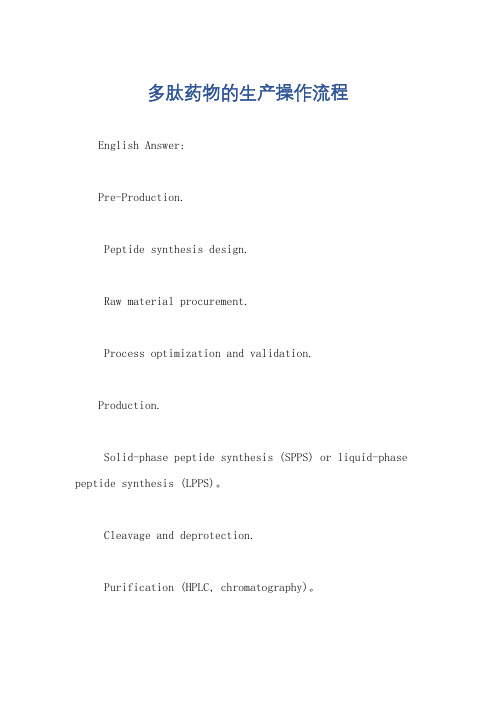
多肽药物的生产操作流程English Answer:Pre-Production.Peptide synthesis design.Raw material procurement.Process optimization and validation.Production.Solid-phase peptide synthesis (SPPS) or liquid-phase peptide synthesis (LPPS)。
Cleavage and deprotection.Purification (HPLC, chromatography)。
Post-Production.Quality control (HPLC, MS)。
Freeze-drying or lyophilization. Formulation and packaging.Quality Assurance.GMP compliance.Regulatory approvals.Stability testing.Additional Considerations.Scale-up and manufacturing.Cost-effectiveness.Market demand.Chinese Answer:生产前。
多肽合成设计。
原料采购。
工艺优化和验证。
生产。
固相多肽合成(SPPS)或液相多肽合成(LPPS)。
切割和脱保护。
纯化(高效液相色谱,色谱法)。
生产后。
质量控制(高效液相色谱,质谱)。
冷冻干燥或冻干。
制剂和包装。
质量保证。
GMP 认证。
监管批准。
稳定性测试。
其他考虑因素。
规模化生产。
成本效益。
市场需求。
y多肽合成路线
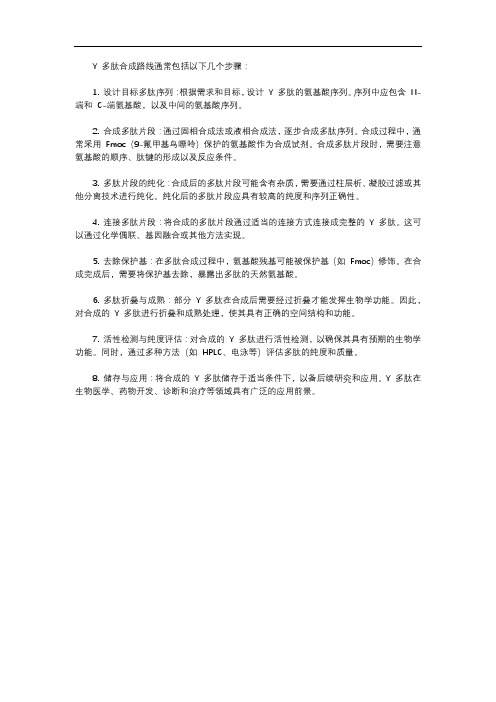
Y 多肽合成路线通常包括以下几个步骤:
1. 设计目标多肽序列:根据需求和目标,设计Y 多肽的氨基酸序列。
序列中应包含N-端和C-端氨基酸,以及中间的氨基酸序列。
2. 合成多肽片段:通过固相合成法或液相合成法,逐步合成多肽序列。
合成过程中,通常采用Fmoc(9-氟甲基鸟嘌呤)保护的氨基酸作为合成试剂。
合成多肽片段时,需要注意氨基酸的顺序、肽键的形成以及反应条件。
3. 多肽片段的纯化:合成后的多肽片段可能含有杂质,需要通过柱层析、凝胶过滤或其他分离技术进行纯化。
纯化后的多肽片段应具有较高的纯度和序列正确性。
4. 连接多肽片段:将合成的多肽片段通过适当的连接方式连接成完整的Y 多肽。
这可以通过化学偶联、基因融合或其他方法实现。
5. 去除保护基:在多肽合成过程中,氨基酸残基可能被保护基(如Fmoc)修饰。
在合成完成后,需要将保护基去除,暴露出多肽的天然氨基酸。
6. 多肽折叠与成熟:部分Y 多肽在合成后需要经过折叠才能发挥生物学功能。
因此,对合成的Y 多肽进行折叠和成熟处理,使其具有正确的空间结构和功能。
7. 活性检测与纯度评估:对合成的Y 多肽进行活性检测,以确保其具有预期的生物学功能。
同时,通过多种方法(如HPLC、电泳等)评估多肽的纯度和质量。
8. 储存与应用:将合成的Y 多肽储存于适当条件下,以备后续研究和应用。
Y 多肽在生物医学、药物开发、诊断和治疗等领域具有广泛的应用前景。
多肽合成入门PPT讲稿

N
Y
O
O
R1
R2
+ H2N
N O
N O
Rn N
Rn+1
N
OQ
O
O
R1
R2
XNH
N
N
O
O
R2n+1
R2n+2
N
N
OQ
O
O
• 多肽简介 • 多肽合成原理 • 氨基保护 • 羧基保护 • 侧链功能团的保护 • 肽键生成的方法
氨基保护
• 氨基保护常用的保护基分为烷氧羰基、酰
基,和烷基三大类。因为N烷氧羰基的保护 的氨基酸在接肽时不易发生消旋化,故烷 氧羰基使用最多
氨基保护
• 多肽简介 • 多肽合成原理 • 氨基保护 • 羧基保护 • 侧链功能团的保护 • 肽键生成的方法
羧基保护
• 目前使用的羧基保护大致可以分为三种 • 一种可以用碱皂化脱去,如甲酯、乙酯 • 另一种可以用酸脱酸或碱脱去外,还可以用其
Gln
Q
R基团带负
天冬氨酸
电荷的氨 基酸
(pH=7.0
(aspartic acid) O 谷氨酸(glutamic O
O
时)
acid)
O
N O
H 2
C
O O
N
O
O
O
C H2
Asp Glu
D E
N
R基团带正 赖氨酸(lysine) N
N C
O
H2
Lys
K
电荷的氨 基酸
(pH=7.0
精氨酸
N
(arginine)
N
O O N
CH3 CH
CH 3
多肽固相合成步骤英文描述

多肽固相合成步骤英文描述多肽固相合成是一种合成肽链的方法,它涉及到多个步骤。
以下是多肽固相合成的步骤和英文描述:1. 准备载体:选择适当的树脂,如弱碱性丙烯酰胺树脂(Acrylamide resin)。
Prepare resin: select an appropriate resin, such as weakly basic acrylamide resin.2. 载体预处理:将树脂进行预处理,如使用二氯甲烷和二甲基甲酰胺进行交替洗涤,实现树脂表面的清洁和活化。
Pre-treatment of the resin: pre-treat the resin, such as alternating washing with dichloromethane and dimethylformamide to achieve a clean and activated resin surface.3. 防止侧反应:在肽链合成过程中,需要采取措施防止侧反应的发生,例如使用保护基。
Prevent side reactions: measures need to be taken to prevent side reactions during peptide synthesis, such as using protective groups.4. 合成肽链:通过加入氨基酸单元和活化剂,将肽链逐步合成。
Synthesize the peptide chain: synthesize the peptide chain step by step by adding amino acid units and activators.5. 洗脱肽链:用酸性溶液或氢氟酸将肽链从树脂上洗脱。
Elute the peptide chain: elute the peptide chain from the resin using an acidic solution or hydrogen fluoride.6. 去保护基:使用适当的溶液去除保护基。
多肽偶联的生产工艺流程
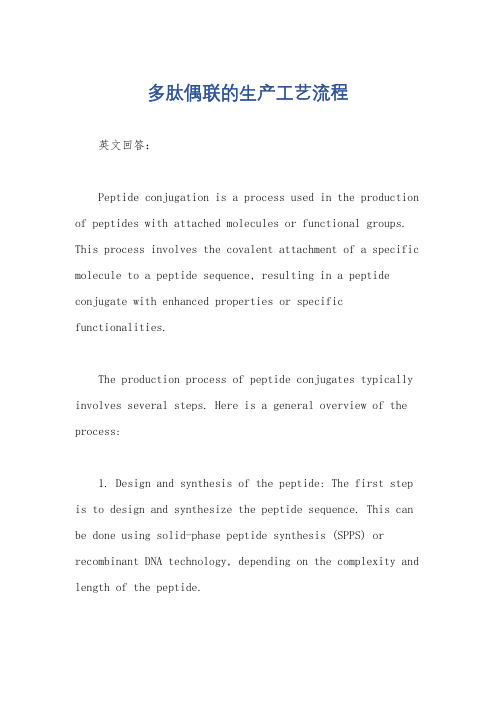
多肽偶联的生产工艺流程英文回答:Peptide conjugation is a process used in the production of peptides with attached molecules or functional groups. This process involves the covalent attachment of a specific molecule to a peptide sequence, resulting in a peptide conjugate with enhanced properties or specific functionalities.The production process of peptide conjugates typically involves several steps. Here is a general overview of the process:1. Design and synthesis of the peptide: The first step is to design and synthesize the peptide sequence. This can be done using solid-phase peptide synthesis (SPPS) or recombinant DNA technology, depending on the complexity and length of the peptide.2. Activation of the peptide: Once the peptide is synthesized, it needs to be activated to create a reactive site for conjugation. This can be achieved by introducing a specific functional group, such as a carboxyl group or an amine group, to the peptide.3. Selection and preparation of the molecule to be conjugated: The next step is to select the molecule or functional group that will be attached to the peptide. This molecule can be a drug, a fluorescent dye, a targeting ligand, or any other molecule of interest. The molecule is then prepared for conjugation by introducing a reactive group that can react with the activated peptide.4. Conjugation reaction: The activated peptide and the prepared molecule are mixed together in a suitable reaction buffer or solvent. The reaction conditions, such as temperature, pH, and reaction time, are optimized to ensure efficient conjugation. The reactive groups on the peptide and the molecule react with each other, forming a covalent bond and resulting in the formation of the peptide conjugate.5. Purification and characterization: After the conjugation reaction, the peptide conjugate needs to be purified to remove any unreacted peptide or molecule. Thisis typically done using techniques such as chromatographyor filtration. The purified peptide conjugate is then characterized using analytical techniques, such as mass spectrometry or nuclear magnetic resonance (NMR), toconfirm its structure and purity.6. Evaluation of the conjugate's properties: The final step is to evaluate the properties of the peptide conjugate, such as its stability, solubility, bioactivity, and pharmacokinetics. This can be done through in vitro and in vivo studies to assess the conjugate's potentialapplications in various fields, such as drug delivery, diagnostics, or therapeutics.中文回答:多肽偶联是一种在多肽生产中常用的过程,用于在多肽序列上连接分子或功能基团。
抗多肽制备流程及原理 PPT

R1
R2
H2N
N O
N O
Rn N
Rn+1
N
OH
O
O
3、2 多肽合成原理
化学合成多肽就把氨基酸依照一定的氨基酸排列 顺序和连接方式连接起来。
为了得到具有特定氨基酸顺序的合成多肽,采纳逐
步缩合的定向合成方法,即先将不需要反应的氨基
或羧基用适当的基团保护起来,再进行连接反应,
以保证反应的定向进行。
R1
另一方面,太短的多肽(<10个氨基酸)则会产生识别 特异性特别强的抗体,以至于无法识别整体蛋白,或亲 和性特别低。因此综合考虑制备性抗原地多肽有效长 度一般是10-20个氨基。这种长度的多肽序列会最大 程度的减小生化合成困难,具有一定的水溶性,也会具 有一定程度的二级结构。
(6) 设计合成多肽 一旦抗原序列决定后,接下来就是设计所需合成的
3、6 肽键生成的方法
形成肽键的方法基本能够分为四类:一是羧基 活化法;二是氨基活化法;三是四组份合成法;四是 利用蛋白水解酶的逆反应,亦称酶促合成法。
羧基活化法的基本原理是先将N-保护氨基酸 或肽的a-羧基转变成活化型的RCOX,从而有利于 N来H说2R,取’对代它基进团行X亲的核吸反电应子生性成越R强C,O其N对H羧R’基。的一活般化 能力也越强。
要如此做。
3、 多肽合成原理
3、1多肽简介 肽键是蛋白质分子中氨基酸间的主要连接方式,是
一 胺个键a。lp一ha个-N氨H基2和酸一的个αa-羧lph基a-与CO另O一H脱个水氨缩基合酸而的成α-氨的基酰 之间失去一分子水相互连接而成的化合物称为肽 (peptide),由2 个氨基酸缩合形成的肽叫二肽,由3 个氨 基酸缩合形成的肽叫三肽,少于10 个氨基酸的肽称为 寡肽,由10个以上氨基酸形成的肽叫多肽,因此蛋白质 的结构就是多肽链结构。每个肽在其一端有一自由氨 基,称为氨基端或N-末端,在另一端有一自由羧基,称为 羧基端或C-末端。
多肽合成入门PPT课件

氨基保护
氨基保护常用的保护基分为烷氧羰基、 酰基,和烷基三大类。因为N烷氧羰基的 保护的氨基酸在接肽时不易发生消旋化, 故烷氧羰基使用最多
10
氨基保护
11
多肽简介 多肽合成原理 氨基保护 羧基保护 侧链功能团的保护 肽键生成的方法
12
羧基保护
目前使用的羧基保护大致可以分为三种 一种可以用碱皂化脱去,如甲酯、乙酯 另一种可以用酸脱去,如叔丁酯、对甲
甘氨酸(glycine)
N
N
O
O
N
N
O O
N S
N
N O
N O
N
O
O
C H3
C H3 H
2 C
CH3 CH
CH3 N
H 2
C
N
C H2
H
2
多肽合成简介
1
多肽合成简介
多肽简介 多肽合成原理 氨基保护 羧基保护 侧链功能团的保护 肽键生成的方法
2
多肽简介
蛋白质的基本结构单位 是氨基酸,由20种氨基 酸组成的各种各样的蛋 白质。
每个氨基酸分子(脯氨 酸除外)alpha碳原子上 都结合一个-NH2、一个COOH、一个氢原子,和 一个各不相同的-R
O
O
O
极性不
苏氨酸 (threonine)
N
H3C
HC
O
O
O
Thr
T
带电荷R 基氨基
半胱氨酸 (cysteine)
N
H
2
C
S
O
S
Cys
C
酸
酪氨酸
(tyrosine)
O
N
O
O
H 2
多肽设计原理和方法PPT课件

.
16
案例5 同一蛋白质不同亚型的多肽设 计 NFKB1
.
17
案例6 同一蛋白质不同亚型的多肽设计 CXCR3
The CXCR3 protein belongs to G protein-coupled receptor family. Several alternatively spliced transcript variants encoding distinct isoforms have been reported.The CXCR3B protein contains 416 amino acids and has a longer N terminus that differs from the original 368-amino acid CXCR3 protein, CXCR3A, in the first 52 residues. This antibody, 60065-1-Ig, is specific for CXCR3B, not binding CXCR3A.
Query 1
WDEVS----------———- VLDDQRRLTRTFEA 19
WDEVS
. VLD ++RLT TF+A Sbjc8 t
69 WDEVSLNAKDLVRKLIVLDPKKRLT- TFQA 97
案例2 家族性蛋白的多肽设计 (transgelin)
The transgelin family is a group of proteins that belong to 22kd actin-related corpnin superfamily.
DPAYIKIEEVIGTGSFGEVRQGRLQPRGRREQTVAIQALWAGGAESLQMTFLGRAAV
多肽药生产合成
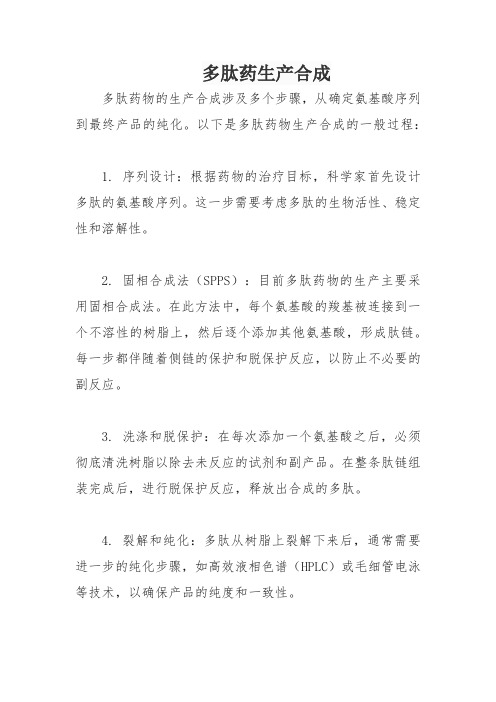
多肽药生产合成
多肽药物的生产合成涉及多个步骤,从确定氨基酸序列到最终产品的纯化。
以下是多肽药物生产合成的一般过程:
1. 序列设计:根据药物的治疗目标,科学家首先设计多肽的氨基酸序列。
这一步需要考虑多肽的生物活性、稳定性和溶解性。
2. 固相合成法(SPPS):目前多肽药物的生产主要采用固相合成法。
在此方法中,每个氨基酸的羧基被连接到一个不溶性的树脂上,然后逐个添加其他氨基酸,形成肽链。
每一步都伴随着侧链的保护和脱保护反应,以防止不必要的副反应。
3. 洗涤和脱保护:在每次添加一个氨基酸之后,必须彻底清洗树脂以除去未反应的试剂和副产品。
在整条肽链组装完成后,进行脱保护反应,释放出合成的多肽。
4. 裂解和纯化:多肽从树脂上裂解下来后,通常需要进一步的纯化步骤,如高效液相色谱(HPLC)或毛细管电泳等技术,以确保产品的纯度和一致性。
5. 分析和表征:使用质谱、核磁共振(NMR)和氨基酸分析等技术对多肽的结构和组成进行详细分析和表征。
6. 冻干和包装:纯化后的多肽通常通过冻干的方式保存,以延长其稳定性。
然后按照适宜的剂量单位进行包装,准备作为药物产品销售。
7. 质量控制:在整个生产过程中,必须严格执行质量控制措施,以确保所有批次的多肽药物都符合规定的安全性、纯度和效力标准。
多肽药物的生产合成是一个精细和复杂的过程,要求高度专业的设备和技术。
由于多肽分子本身的多样性和复杂性,合成过程中可能遇到多种挑战,如序列复杂性、合成效率、多肽稳定性和成本控制等。
随着技术的进步,多肽药物的生产方法也在不断优化,以提高产量、降低成本并简化生产流程。
体外生物合成多肽实验步骤
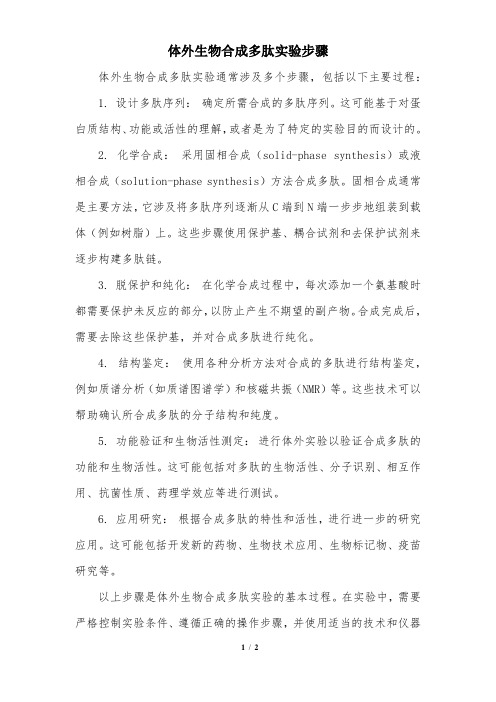
体外生物合成多肽实验步骤
体外生物合成多肽实验通常涉及多个步骤,包括以下主要过程:
1. 设计多肽序列: 确定所需合成的多肽序列。
这可能基于对蛋白质结构、功能或活性的理解,或者是为了特定的实验目的而设计的。
2. 化学合成: 采用固相合成(solid-phase synthesis)或液相合成 (solution-phase synthesis)方法合成多肽。
固相合成通常是主要方法,它涉及将多肽序列逐渐从C端到N端一步步地组装到载体 (例如树脂)上。
这些步骤使用保护基、耦合试剂和去保护试剂来逐步构建多肽链。
3. 脱保护和纯化: 在化学合成过程中,每次添加一个氨基酸时都需要保护未反应的部分,以防止产生不期望的副产物。
合成完成后,需要去除这些保护基,并对合成多肽进行纯化。
4. 结构鉴定: 使用各种分析方法对合成的多肽进行结构鉴定,例如质谱分析 (如质谱图谱学)和核磁共振 (NMR)等。
这些技术可以帮助确认所合成多肽的分子结构和纯度。
5. 功能验证和生物活性测定: 进行体外实验以验证合成多肽的功能和生物活性。
这可能包括对多肽的生物活性、分子识别、相互作用、抗菌性质、药理学效应等进行测试。
6. 应用研究: 根据合成多肽的特性和活性,进行进一步的研究应用。
这可能包括开发新的药物、生物技术应用、生物标记物、疫苗研究等。
以上步骤是体外生物合成多肽实验的基本过程。
在实验中,需要严格控制实验条件、遵循正确的操作步骤,并使用适当的技术和仪器
进行分析和验证,以确保合成多肽的成功和可靠性。
多肽合成工艺流程
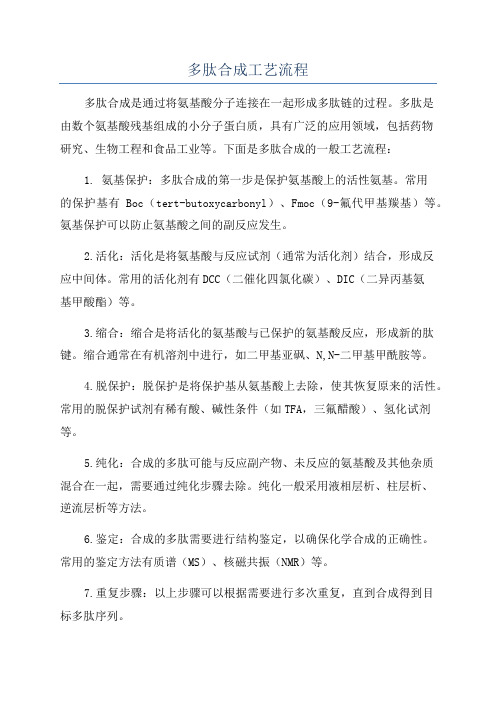
多肽合成工艺流程多肽合成是通过将氨基酸分子连接在一起形成多肽链的过程。
多肽是由数个氨基酸残基组成的小分子蛋白质,具有广泛的应用领域,包括药物研究、生物工程和食品工业等。
下面是多肽合成的一般工艺流程:1. 氨基保护:多肽合成的第一步是保护氨基酸上的活性氨基。
常用的保护基有Boc(tert-butoxycarbonyl)、Fmoc(9-氟代甲基羰基)等。
氨基保护可以防止氨基酸之间的副反应发生。
2.活化:活化是将氨基酸与反应试剂(通常为活化剂)结合,形成反应中间体。
常用的活化剂有DCC(二催化四氯化碳)、DIC(二异丙基氨基甲酸酯)等。
3.缩合:缩合是将活化的氨基酸与已保护的氨基酸反应,形成新的肽键。
缩合通常在有机溶剂中进行,如二甲基亚砜、N,N-二甲基甲酰胺等。
4.脱保护:脱保护是将保护基从氨基酸上去除,使其恢复原来的活性。
常用的脱保护试剂有稀有酸、碱性条件(如TFA,三氟醋酸)、氢化试剂等。
5.纯化:合成的多肽可能与反应副产物、未反应的氨基酸及其他杂质混合在一起,需要通过纯化步骤去除。
纯化一般采用液相层析、柱层析、逆流层析等方法。
6.鉴定:合成的多肽需要进行结构鉴定,以确保化学合成的正确性。
常用的鉴定方法有质谱(MS)、核磁共振(NMR)等。
7.重复步骤:以上步骤可以根据需要进行多次重复,直到合成得到目标多肽序列。
需要注意的是,多肽合成是一个复杂而精细的过程,需要严格控制反应条件、反应时间和试剂用量等因素,以确保多肽的高纯度和高收率。
此外,对于较长的多肽链,还需要考虑到固相合成的方法,其中合成的多肽链通过终止剂与固相载体连接,并在每次反应后进行洗脱步骤。
总结起来,多肽合成的工艺流程包括氨基保护、活化、缩合、脱保护、纯化、鉴定以及重复步骤等。
合成多肽的过程需要仔细控制反应条件和试剂用量,以确保高纯度和高收率的产物。
多肽偶联的生产工艺流程

多肽偶联的生产工艺流程英文回答:Polypeptide Conjugation Manufacturing Process.1. Raw Material Preparation.Synthetic peptides and proteins are synthesized using solid-phase peptide synthesis (SPPS) or recombinant DNA technology. The raw materials used in SPPS include amino acids, coupling reagents, and solvents.2. Peptide Synthesis.Peptides are synthesized by sequential addition of amino acids to a growing peptide chain. The amino acids are activated using coupling reagents and added to the peptide chain. The reaction is repeated until the desired peptide sequence is obtained.The crude peptide is purified using techniques such as high-performance liquid chromatography (HPLC) orpreparative electrophoresis. The purified peptide is then characterized using mass spectrometry and other analytical methods.4. Conjugation.The purified peptide is conjugated to a carrier molecule. The carrier molecule can be a protein, antibody,or other biomolecule. The conjugation reaction is typically performed using chemical cross-linkers or enzymatic methods.5. Purification.The conjugated product is purified using techniquessuch as HPLC or ultrafiltration. The purified conjugate is then characterized using mass spectrometry and other analytical methods.The conjugated product is formulated into a suitable dosage form. The formulation may include excipients such as buffers, stabilizers, and preservatives. The dosage form can be a liquid, powder, or lyophilized solid.7. Quality Control.The final product is subjected to quality control testing to ensure that it meets the specifications for purity, potency, and safety. The testing may include assays for peptide content, conjugation efficiency, and biological activity.中文回答:多肽偶联生产工艺流程。
多肽固相合成法操作
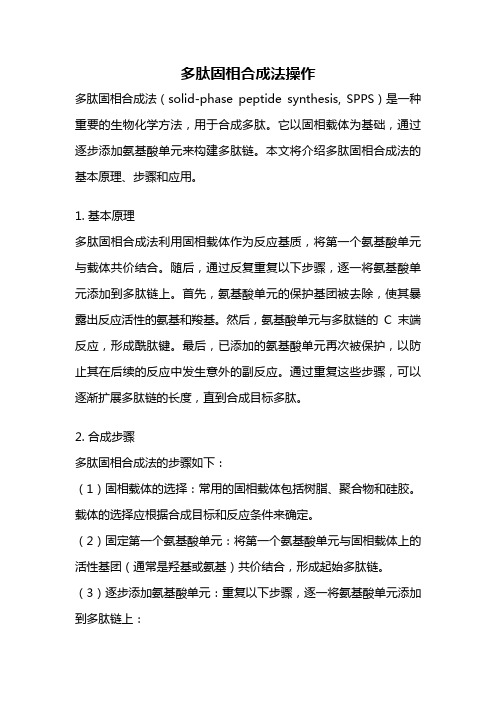
多肽固相合成法操作多肽固相合成法(solid-phase peptide synthesis, SPPS)是一种重要的生物化学方法,用于合成多肽。
它以固相载体为基础,通过逐步添加氨基酸单元来构建多肽链。
本文将介绍多肽固相合成法的基本原理、步骤和应用。
1. 基本原理多肽固相合成法利用固相载体作为反应基质,将第一个氨基酸单元与载体共价结合。
随后,通过反复重复以下步骤,逐一将氨基酸单元添加到多肽链上。
首先,氨基酸单元的保护基团被去除,使其暴露出反应活性的氨基和羧基。
然后,氨基酸单元与多肽链的C末端反应,形成酰肽键。
最后,已添加的氨基酸单元再次被保护,以防止其在后续的反应中发生意外的副反应。
通过重复这些步骤,可以逐渐扩展多肽链的长度,直到合成目标多肽。
2. 合成步骤多肽固相合成法的步骤如下:(1)固相载体的选择:常用的固相载体包括树脂、聚合物和硅胶。
载体的选择应根据合成目标和反应条件来确定。
(2)固定第一个氨基酸单元:将第一个氨基酸单元与固相载体上的活性基团(通常是羟基或氨基)共价结合,形成起始多肽链。
(3)逐步添加氨基酸单元:重复以下步骤,逐一将氨基酸单元添加到多肽链上:- 去保护基团:使用适当的试剂去除氨基酸单元的保护基团,使其暴露出反应活性的氨基和羧基。
- 反应形成酰肽键:将氨基酸单元与多肽链的C末端反应,形成酰肽键。
- 保护新添加的氨基酸单元:为防止其在后续反应中发生副反应,需要对新添加的氨基酸单元进行保护。
(4)多肽链的完整性测试:在合成结束后,需要对多肽链的完整性进行测试,以确保合成目标的多肽已经成功合成。
3. 应用多肽固相合成法在生物医学研究和药物开发中具有广泛的应用。
它可以用于合成天然多肽、合成突变多肽、合成活性肽和合成药物前体等。
通过调整合成方法和反应条件,可以合成具有特定结构和功能的多肽,用于研究生物活性、药理学和临床治疗。
总结:多肽固相合成法是一种重要的生物化学方法,用于合成多肽。
多肽合成方法科普

多肽合成方法科普多肽合成是指通过化学方法将氨基酸分子按照特定的顺序连接起来形成多肽链的过程。
多肽合成方法包括固相合成和液相合成两种主要方法。
以下将详细介绍这两种方法以及它们的优缺点。
一、固相合成方法(Solid-phase peptide synthesis,SPPS)固相合成方法是目前多肽合成中最常用的方法之一、这种方法利用聚合物固相材料作为载体,在上面逐步进行氨基酸的化学反应,最终形成多肽链。
固相合成方法的步骤如下:1. 首先在聚合物固相材料上固定一个保护基团,常见的保护基团有Fmoc(9-氟芴甲酰氨基),Boc(正丁氧羰基)等。
2.将保护基团暴露出来,使之暂时解除保护,连接第一个氨基酸的氨基到固相材料上。
3.通过反应剂将氨基酸连接到固相材料上,形成肽键。
反应剂一般为活化剂,如DCCI(二乙基氨基甲酰氯)等。
4.让制得的肽链继续暴露出下一个氨基酸的保护基团,再次与上述步骤中的第3步相同的方式来连接下一个氨基酸。
5.重复步骤3和步骤4,直到合成完整的多肽。
固相合成方法的优点:1.可以方便地控制肽链的长度和序列,灵活性很高。
2.高化学纯度,少数杂质的污染程度较低。
3.可以合成较长的多肽。
固相合成方法的缺点:1.比较复杂且需要多个步骤进行,合成周期较长。
2.合成规模的限制,只能合成尺寸较小的多肽。
3.一些氨基酸可能会出现降解。
二、液相合成方法(Liquid-phase peptide synthesis,LPPS)液相合成方法是另一种常用的多肽合成方法,该方法在溶液中逐步进行氨基酸的化学反应,最终形成多肽链。
液相合成方法的步骤如下:1.首先需要选择合适的保护基团,将氨基酸的羧基和氨基保护起来。
2.将保护基团暴露出来,使之暂时解除保护,连接第一个氨基酸。
3.将制得的肽链反应溶液与新的氨基酸反应,形成肽键。
4.重复步骤2和步骤3,直到合成完整的多肽。
液相合成方法的优点:1.可以合成大尺寸的多肽。
2.合成速度较快,合成周期较短。
多肽的固相合成课件

重复上述肽键形成反应,使肽链从C 端向N端生长,直至达到所需要的肽 链长度。最后脱去保护基X,用HF 水解肽链和固相载体之间的酯键, 就得到了合成好的肽。
方法流程图
能用于多肽合成的固相载体必须满足如下 要求:必须包含反应位点(或反应基团), 以使肽链连在这些位点上,并在以后除去; 必须对合成过程中的物理和化学条件稳定; 载体必须允许在不断增长的肽链和试剂之 间快速的、不受阻碍的接触;另外,载体 必须允许提供足够的连接点,以使每单位 体积的载体给出有用产量的肽,并且必须 尽量减少被载体束缚的肽链之间的相互作 用。
人有了知识,就会具备各种分析能力, 明辨是非的能力。 所以我们要勤恳读书,广泛阅读, 古人说“书中自有黄金屋。 ”通过阅读科技书籍,我们能丰富知识, 培养逻辑思维能力; 通过阅读文学作品,我们能提高文学鉴赏水平, 培养文学情趣; 通过阅读报刊,我们能增长见识,扩大自己的知识面。 有许多书籍还能培养我们的道德情操, 给我们巨大的精神力量, 鼓舞我们前进。
具体合成由下列几个循环组成: 1. 去保护:Fmoc保护的柱子和单体必须用一 种碱性溶剂(piperidine)去 除氨基的保护基团。 2. 激活和交联:下一个氨基酸的羧基被一种 活化剂所活化。活化的单体与游离的氨基反应交 联,形成肽键。在此步骤使用大量的超浓度试剂 驱使反应完成。循环:这两步反应反复循环直到 合成完成。 3. 洗脱和脱保护:多肽从柱上洗脱下来,其 保护基团被一种脱保护剂(TFA) 洗脱和脱保护
多肽的固相合成
组长:徐磊 组员:许金祥,尚立群,王修楠, 钟佳伟
英文解释: solid phase peptide synthesis 简写为SPPS
在肽合成的技术方面 取得了突破性进展的 是R.Bruce Merrifield, 他设计了一种肽的合 成途径并定名为固相 合成途径。由于 R.BruceMerrifield在肽 合成方面的贡献, 1984年获得了诺贝尔 奖
生物多肽工艺流程

生物多肽工艺流程(共3页) -本页仅作为预览文档封面,使用时请删除本页-生物多肽工艺流程一、固相肽合成(1)投料:树脂加入固相合成仪,加入DCM溶胀,抽干后加入DMF洗涤,洗涤结束抽干备用。
(2)缩合:将氨基酸用一定体积的DMF溶解,加入缩合剂活化后投入固相合成仪,补充DMF至反应浓度,搅拌反应。
(3)脱除保护基:以Kaiser试剂检测反应程度,反应结束后抽干溶剂,DMF洗涤,加入PIP/DMF溶液脱除保护基,以Kaiser试剂检测反应程度,反应完毕抽干溶剂,DMF洗涤,准备加入下一个氨基酸。
(4)缩合循环:按照树脂序列依次连接氨基酸,按照“脱保护——洗涤——活化氨基酸——投料缩合——洗涤”步骤进行缩合循环操作,按照氨基酸序列完成剩余n个氨基酸的缩合。
(5)出料:合成结束之后用IPA和DCM交叉洗涤树脂,完成树脂收缩收缩,出料至不锈钢托盘。
(6)树脂干燥:树脂在真空干燥箱中室温干燥,干燥完毕称重,计算收率。
(7)有机废液回收,集中处理。
(8)清场:操作结束后操作人员及时清场。
二、树脂裂解(1)配液:按照裂解液成分比例配置裂解液,并提前置冰柜中冷藏保存。
(2)投料:肽树脂加入反应釜中,加入预冷的裂解液,搅拌反应。
(3)出料:裂解结束后放出反应液,抽滤除去树脂并以TFA洗涤。
(4)浓缩:裂解液转入旋转蒸发仪室温浓缩至小体积。
(5)析出:浓缩后的反应液倾入预冷的甲基叔丁基醚(简称醚)中,搅拌使析出大量固体。
(6)离心:浊液离心,并用预冷的醚洗涤。
(7)粗肽干燥:涤完成的粗肽转至真空干燥箱中室温干燥。
(8)有机废液回收,集中处理。
(9)清场:操作结束后操作人员及时清场。
三、多肽HPLC纯化(1)溶解:操作人员将粗肽溶解,调节PH至工艺规定范围。
(2)过滤:滤去粗肽溶液中不溶物,过滤ACN和纯化水。
(3)配制纯化液:根据工艺内容配制A相(乙腈)和B相(水)。
(4)纯化:在制备型液相上进行纯化,分别接收流份。
- 1、下载文档前请自行甄别文档内容的完整性,平台不提供额外的编辑、内容补充、找答案等附加服务。
- 2、"仅部分预览"的文档,不可在线预览部分如存在完整性等问题,可反馈申请退款(可完整预览的文档不适用该条件!)。
- 3、如文档侵犯您的权益,请联系客服反馈,我们会尽快为您处理(人工客服工作时间:9:00-18:30)。
90% TFA solution for effective removal.
-SH (Cys)
trityl (Trt)
For selective deprotection
CH2 NH C CH3 O
acetamidomethyl (Acm)
Racemisation during the attachment of Cys derivatives to the resins
C H3 Trt group can be used if on-resin derivatization is required (glycosylation,
phosphorylation). Trt can be cleaved with diluted TFA, while tBu needs
4-Alkoxybenzyl alcohol (Wang) resin:
HO CH2
O CH2
P
Attachment of the first amino acid: Fmoc-Aaa(X)-OH:DIC:DMAP (2:2:0.2 equiv to the resin OH content) in DMF, 1h at RT.
Applied side chain protecting groups in Fmoc-chemistry
Side chain functional group protecting group name (abbreviation)
-OH (Ser, Thr, Tyr)
CH3 H3C C
tert-butyl (tBu)
4-Hydroxymethylphenoxyacetic acid (HMPA) linker:
HO CH2
O CH2 COOH Attach to aminomethyl PS-DVB resin
Removal of the peptide with TFA
4-(4-Hydroxymethyl-3-methoxyphenoxy)butyric acid (HMPB) linker:
Advantages:
excellent pressure stability (continuous flow synthesis) excellent swelling properties (also in water) high diffusion rates available with many types of functional groups low capacity (0.2-0.6 mmol/g), suitable for the synthesis of aggregating peptides, for on resin cyclisation and fragment condansation.
Outline
Resins; Protecting groups; Synthetic protocol; Monitoring; Cleavage technics; Side reactions;
Fmoc/tBu:
Fmoc
tert-butyl
H3C
H3C H3C C CH3
OCH2-P
Rink Amide-AM and Rink Amide-MBHA resins:
OCH3
H3CO Fmoc-HN CH
OCH2-CO-Nle-R
H2N CH2
P
Aminomethyl-PS-DVB
CH3
Peptide cleavage with 90-95% TFA solution.
enantiomerisation!
Determination of loading
(Calculation of the resin capacity) 1.
10-20 mg of dried resin are weighted exactly into a 100 mL measuring flask (for a load of ca. 0.5 meq/g 20 mg is sufficient);
peptides (available for fragment condensation).
ClTrt resin prevents the diketopiperazine formation ! Attachment of Cys and His derivatives to the resin is free from
Similar to Wang resin
4-carboxytrityl linker
O
NovaSyn R TGT alcohol resin
HO
C OH Before use the resin must be converted
to the chloride form by heating with
NH2(mmol/g) = [A301.V(ml)/e301.m(mg)].106
2. ca. 4-6 mg Fmoc-Aaa-resin +400 mL 50% piperidine/DMF 30 min at RT, then filtration dilute with MeOH to 25 mL
Solid phrt II
Application of Fmoc/tBu strategy
Gábor Mező
Research Group of Peptide Chemistry Hungarian Academy of Sciences Eötvös L. University Budapest, Hungary
AcCl or SOCl2 in toluene. Similar to ClTrt resin.
OCH3 H3CO
H2N CH
2,4-dimethoxy-benzhydryl linker NovaSyn R TGR resin
Similar to Rink Amide MBHA resin O
OCH2 C OH
ca. 2 mg Fmoc-Gly-OH +400 mL 50% piperidine/DMF 30 min at RT dilute with MeOH to 25 mL
Capacity of the resin (mmol/g) =
1000.mgly.A3r0es1 in Mgly.mresin.A3g0ly1
1 g ClTrt-resin + 2 mmol Fmoc-Aaa(X)-OH + 8 mmol DIEA in 3-5 mL DCM, for 1.5 h then 0.8 mL MeOH to block the unreacted groups washing with DCM, iPrOH, MeOH, ether
Mgly =297
Rink Amide Resin: synthesis of peptides with CONH2 C-terminus
Cleavage with high concentration of TFA can lead to the break down of
OCH3
the linker
Cl Cl
The final cleavage results in peptides with COOH group at the C-terminus
Cleavage with 90-95% TFA + scavangers results in free peptides Cleavage with AcOH:MeOH(TFE):DCM (1:1:8 or 2:2:6) results in protected
in the presence of DMAP: Fmoc-Cys(Trt)-OH > Fmoc-Cys(Acm)-OH
However, Fmoc-Cys(Acm) at the C-terminal resultes in side reaction:
NH CH C O CH2
O CH2
P
Acm-S CH2 O
SASRIN (Super Acid Sensitive ResIN) (2-methoxy-4-alkoxybenzyl-alcohol resin)
HO CH2
O CH2
P
CH3O
Peptide is cleavable with 0.5-1.0% TFA in DCM resulted in protected peptide fragments.
The basic polymer support is aminomethyl PEG-PS-DVB (NovaSyn R TG) NH2 PEG
HO C H2
O O CH2 C OH
4-hydroxymethylphenoxyacetic acid linker
NovaSyn R TGA resin
There are many different resins and most of them are used for special cases and in individual laboratories. Here only the most widely applied resins will be presented. Resins are based on PS-DVB (1%) copolymer.
HO CH2 CH3O
O (CH2)3 C OOH Attach to aminomethyl PS-DVB resin
Removal of the peptide with diluted TFA
2-Chlorotrityl chloride (ClTrt) resin:
